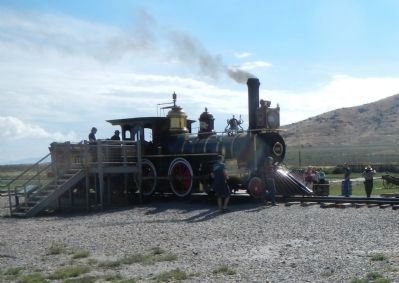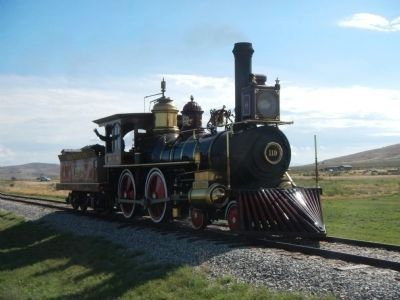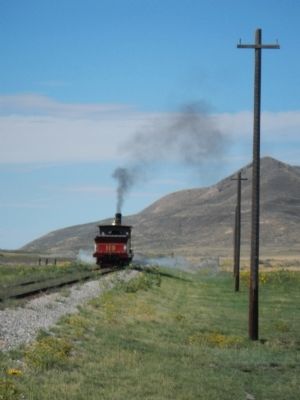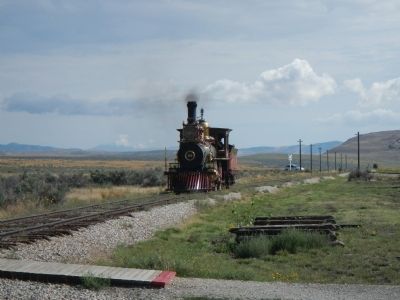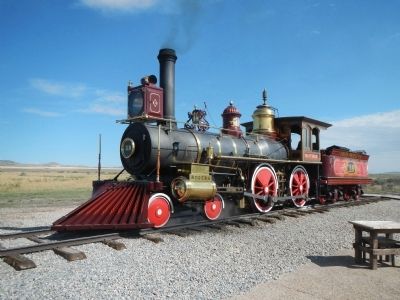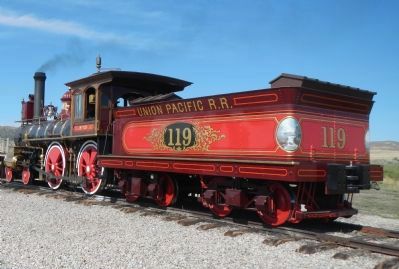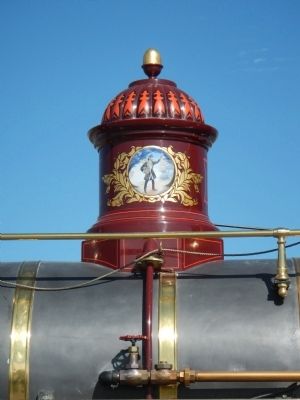Near Corinne in Box Elder County, Utah — The American Mountains (Southwest)
The Locomotives of Golden Spike - No. 119
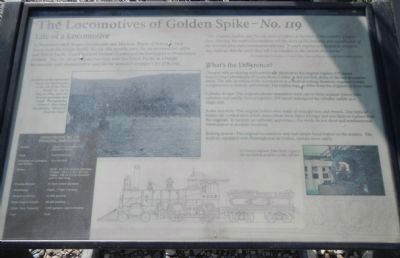
Photographed By Barry Swackhamer, August 27, 2014
1. The Locomotives of Golden Spike - No. 119 Marker
Captions: (right center) Members of the regimental band, 21st Infantry pose on the side of the Union Pacific No. 119 on May 10, 1869, after the formal ceremony has ended. Photographer Alfred A. Hart titled this picture, “Monarch from the East.”; (bottom left) O’Connor engineer John Healy inspects the machining accuracy of the cylinders.; (bottom left) Union Pacific No. 119 Principal Dimensions. Click on this image to enlarge it a read the chart.
Life of a Locomotive
In November 1868, Rogers Locomotive and Machine Works of Patterson, New Jersey built the Union Pacific No. 119. Six months later, No.119 received the call to pull Union Pacific’s Vice-President Thomas Durant and contingent to Promontory Summit. The No.119 served out her days with the Union Pacific as a freight locomotive until dismantled in 1903 for the standard scrappers fee of $1,000.
What’s the Difference?
Charged with producing replicas virtually identical to the original engines, O’Connor Engineering Laboratories of Costa Mesa, California did just that, down to the last decorative detail. The safe operation of the locomotives in a modern setting, however, required certain compromises in historic authenticity. The replica engines differ from the originals in three ways:
Cylinder design-The original cylinder assemblies were cast in three separate pieces (two cylinders and saddle) bolted together. O’Connor redesigned the cylinder-saddle as a single unit.
Boiler assembly-The original boilers were made out of wrought iron and riveted. The replica’s boilers are welded steel, which makes them many times stronger and less likely to rupture than the originals. To recreated an authentic appearance, the welds do not show and nonfunctional rivets appear in accurate locations.
Braking system-The original locomotives only had simple hand brakes on the tenders. The replicas, equipped with Westinghouse air brakes, operate more safely.
Erected by National Park Service, U.S. Department of the Interior.
Topics. This historical marker is listed in this topic list: Railroads & Streetcars. A significant historical month for this entry is November 1868.
Location. 41° 37.084′ N, 112° 33.092′ W. Marker is near Corinne, Utah, in Box Elder County. Marker can be reached from Golden Spike Road (22000 West Road) near 6400 North Road, on the right when traveling west. Touch for map. Marker is in this post office area: Corinne UT 84307, United States of America. Touch for directions.
Other nearby markers. At least 8 other markers are within walking distance of this marker. May 9, 1869 (a few steps from this marker); September 1869 (a few steps from this marker); The Locomotives of Golden Spike - Jupiter
(a few steps from this marker); September 8, 1942 (within shouting distance of this marker); May 10, 1869 (within shouting distance of this marker); a different marker also named September 1869 (within shouting distance of this marker); Competition 1869 (within shouting distance of this marker); Irish Monument (within shouting distance of this marker). Touch for a list and map of all markers in Corinne.
More about this marker. This marker is located in the exhibit area behind the Golden Spike Visitors Center.
Also see . . . Union Pacific No. 119 - Wikpedia. Durant, the vice president of the Union Pacific Railroad was traveling on the so-called Durant Special for the ceremony at Promontory. A swollen river had washed away some supports to the Devil's Gate Bridge. Durant's engineer refused to take the current engine across but did consent to nudge the lighter passenger cars across the bridge. The bridge held, the cars made it across but Durant and his entourage were left without an engine. Durant's plight was answered when No. 119 was sent from Ogden to take the Durant Special the short distance to Promontory... (Submitted on February 22, 2015, by Barry Swackhamer of Brentwood, California.)
Additional keywords. The Locomotives of Golden Spike - No. 119
Credits. This page was last revised on June 16, 2016. It was originally submitted on February 22, 2015, by Barry Swackhamer of Brentwood, California. This page has been viewed 616 times since then and 37 times this year. Photos: 1, 2, 3, 4, 5, 6, 7, 8. submitted on February 22, 2015, by Barry Swackhamer of Brentwood, California. • Andrew Ruppenstein was the editor who published this page.
